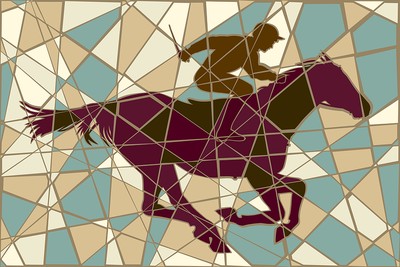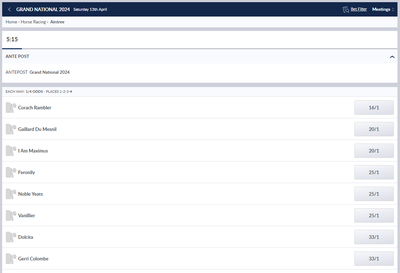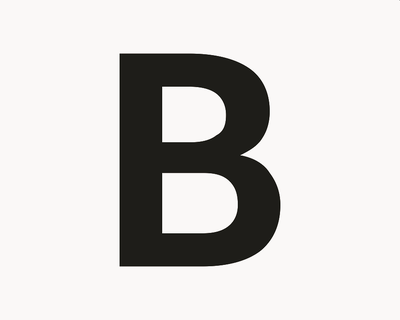 The 1st of October 2022 marked a significant change to the National Hunt classification system as, seemingly from nowhere, races known as “Premier Handicaps” began to appear on the scene. But what are these new kids on the classifications block?
The 1st of October 2022 marked a significant change to the National Hunt classification system as, seemingly from nowhere, races known as “Premier Handicaps” began to appear on the scene. But what are these new kids on the classifications block?
Rather than representing an entirely new category, a Premier Handicap is simply the new name given to those races previously known as Grade 3 Handicaps. From that 1st of October 2022 launch date, any Grade 3 Handicap (and all Grade 3 races were handicaps) immediately became known as a Premier Handicap, with the Grade 3 classification removed from the list of racing terminology.
In Short
In summary, Premier Handicaps are:
- All handicaps which were previously known as Grade 3 handicaps, in addition to a small number upgraded from Listed level.
- The highest class and most prestigious handicaps of the season.
- Handicaps with a relatively high level of prize money
Why Make the Change?

In partnership with a focus group known as the Quality Jump Racing Review Group, the Jump Pattern Committee recommended this change in an effort to make the classification system more transparent to the public.
The committee deemed that the previous term “Grade 3” implied a race of significantly less significance and value than a Grade 1 or Grade 2 contest. In fact, in reality, many of the biggest and most popular events of the year fell into the Grade 3 category, the most glaring example being the Aintree Grand National. In the hope of avoiding questions such as “If the Grand National is such a big race, why is it only a Grade 3?”, the elite-sounding “Premier” was introduced to more accurately reflect the high esteem in which many of these, often historic, races are held.
This rebranding also helps to create a cleaner distinction between Grade 1 and 2 races (which tend to be weight for age events in which the best of the best are crowned), and Handicaps (where all runners have a theoretically equal chance of winning). The previous system – whereby Grade 3 races were both Graded events and Handicaps – was viewed as an unnecessary blurring of the lines.
New Name, Same Conditions
![]()
Other than the rebranding from a Grade 3 Handicap to a Premier Handicap, everything else about the affected races remains the same, whether that be in relation to the age, sex, or experience levels of the runners eligible to compete.
All races in this category will take place under standard handicap conditions. This means that the weight carried by the runners is determined by their handicap mark. As such, the rating assigned to every runner is designed to reflect their level of ability, with one rating point equating to 1lb in weight.
The higher a horse’s handicap mark (also known as its Official Rating), the more weight it will carry in relation to the competition. For example, in a handicap race featuring two horses with ratings of 150 and 140, the higher-rated runner would be required to carry 10lbs more than the lower-rated horse, in an effort to provide both runners with a theoretically equal chance of winning the race.
Top of the Handicap Tree

In order to provide a programme of contests which caters to runners of all ability levels, British Racing operates a Class system, ranging from Class 6, for the lowest-rated runners, all the way up to Class 1, for the most talented performers in the sport. Unsurprisingly, given that “Premier” moniker, these events sit within the Class 1 category, just below the Grade 1 and Grade 2 contests.
The main distinction between a Premier Handicap and a lower-grade handicap relates to the quality of runners eligible to compete. For example, a Class 3 Handicap will often be labelled as a 0-135 handicap, meaning no runner rated higher than 135 qualifies to run in the race.
In contrast, a Premier Handicap may be labelled as an “Open” handicap (as in open to all) or a 0-150+ Handicap, signifying no ceiling to the rating of the runners permitted to run. One consequence of having no upper limit is that the top Premier Handicaps regularly attract a high quality of runner, including those more accustomed to plying their trade at Grade 2 or even Grade 1 level.
 Premier Handicaps are, therefore, the very best handicap races that the sport has to offer. This is a fact which is reflected both in the quality of the runners they attract and the level of prize money on offer.
Premier Handicaps are, therefore, the very best handicap races that the sport has to offer. This is a fact which is reflected both in the quality of the runners they attract and the level of prize money on offer.
Whilst many Premier Handicaps may be labelled as 0-150+ handicaps, there will almost always be a strong bias towards the top end of this range. Lower-rated runners are discouraged from running in such races, thanks to the maximum and minimum weight rules. For example, consider a 0-150+ handicap with a maximum weight of 12st and a minimum weight of 10st2lb, in which the top-rated runner has an official rating of 150.
As the highest-rated runner, this horse would carry the maximum weight of 12st. However, should a horse rated 115 wish to run, they would still be required to carry the minimum weight of 10st2lb, even though, on ratings, they should carry 35lbs less than the 150-rated runner, which would equate to 9st7lb.
In reality, lower-rated runners are often excluded from running anyway, as all races have a maximum field size. Should a race be oversubscribed, it is the highest-rated horses amongst the list of entries who are selected to run.
Premier Handicaps also have a minimum level of prize money, which varies slightly according to race type:
- Handicap Chase – Minimum £40,000 in total prize money
- Handicap Hurdle – Minimum £35,000 in total prize money
- Juvenile and Novice Hurdle – Minimum £35,000 in total prize money
Note that the above values represent only minimum amounts. Many Premier Handicaps offer significantly more than this. The Welsh National is worth £150,000, and the Coral Gold Cup £200,000 – very decent money. However, the Aintree Grand National takes things up several notches, with a cool £1million on offer, making it one of the richest jumps races held anywhere in the world, with only the Nakayama Grand Jump in Japan coming close.
As a result of the carrot provided by the high prize money on offer, the maximum and minimum weight rule, and the maximum field size, Premier Handicaps tend to feature a field of high-quality performers compressed within a relatively small ratings band.
Listed Handicaps are No More

In addition to rebranding Grade 3 handicaps as Premier Handicaps, the October 2022 changes also saw the removal of Listed Handicaps from the racing schedule. The motivation behind this change was again to create clarity within the system by grouping all of the top handicaps together in the “Premier Handicap” category.
As a result of their status, prestige, and the quality of horses they tended to attract, 11 existing Listed Handicaps were promoted into the Premier Handicap category, whilst seven were downgraded to Class 2 level. The odd one out was the EBF Mares’ Novices’ Handicap Chase at Cheltenham, which was upgraded to a Grade 2 contest.
Note that a selection of Listed races still exists on the jumps racing programme, but only those run under non-handicap conditions.
Black Type Remains
 Under the old Classification system, any horse who won or finished placed in a Grade 1, Grade 2, Grade 3, or Listed event would earn the distinction of having their name printed in bold black type in the breeding catalogues. Such an accolade immediately increases the breeding value of the horse in question and their relatives.
Under the old Classification system, any horse who won or finished placed in a Grade 1, Grade 2, Grade 3, or Listed event would earn the distinction of having their name printed in bold black type in the breeding catalogues. Such an accolade immediately increases the breeding value of the horse in question and their relatives.
Any concerns that the rebranding of Grade 3 races would remove one possible route to achieving black type were swiftly alleviated, with the BHA confirming that any horse who wins or finishes placed in a Premier Handicap will receive this honour.
List of Premier Handicaps
Those wishing to take in a Premier Handicap will find no shortage of opportunity, with a total of 51 on offer over the course of the jumps campaign.
| Course | Race | Month |
|---|---|---|
| Aintree | Becher Chase | December |
| Aintree | Red Rum Handicap Chase | April |
| Aintree | William Hill Handicap Hurdle | April |
| Aintree | Topham Chase | April |
| Aintree | Village Hotels Handicap Hurdle | April |
| Aintree | William Hill Handicap Chase | April |
| Aintree | Grand National | April |
| Ascot | Byrne Group Handicap Chase | Oct / Nov |
| Ascot | Bateaux London Gold Cup | Oct / Nov |
| Ascot | Betfair Exchange Trophy Handicap Hurdle | December |
| Ascot | Ascot Silver Cup | December |
| Ascot | Swinley Chase | February |
| Ayr | Scotty Brand Handicap Chase | April |
| Ayr | Scottish Grand National | April |
| Cheltenham | Paddy Power Gold Cup | November |
| Cheltenham | Jewson Handicap Chase | November |
| Cheltenham | Greatwood Hurdle | November |
| Cheltenham | Dahlbury Handicap Chase | December |
| Cheltenham | December Gold Cup | December |
| Cheltenham | Paddy Power Handicap Chase | January |
| Cheltenham | Paddy Power Cheltenham Countdown Handicap Chase | January |
| Cheltenham | Ultima Handicap Chase | March |
| Cheltenham | Boodles Juvenile Handicap Hurdle | March |
| Cheltenham | Coral Cup | March |
| Cheltenham | Johnny Henderson Grand Annual Chase | March |
| Cheltenham | Pertemps Final | March |
| Cheltenham | Magners Plate Handicap Chase | March |
| Cheltenham | County Handicap Hurdle | March |
| Cheltenham | Safran Landing Systems Fillies’ Juv Hcap Hdl | April |
| Chepstow | Welsh Grand National | December |
| Doncaster | Great Yorkshire Chase | January |
| Haydock | Swinton Handicap Hurdle | May |
| Haydock | Betfair Stayers’ Handicap Hurdle | November |
| Haydock | Peter Marsh Chase | January |
| Haydock | Grand National Trial | February |
| Kempton | Coral Trophy Handicap Chase | February |
| Market Rasen | Summer Plate | July |
| Newbury | Gerry Feilden Hurdle | November |
| Newbury | Coral Gold Cup | November |
| Newbury | Betfair Hurdle | February |
| Newbury | Greatwood Gold Cup | Feb / March |
| Newcastle | Rehearsal Handicap Chase | November |
| Sandown | Heroes Handicap Hurdle | Jan / Feb |
| Sandown | EBF Novices’ Handicap Hurdle | March |
| Sandown | Imperial Cup | March |
| Sandown | Betfair Novices’ Handicap Chase | March |
| Sandown | Bet365 Gold Cup | April |
| Uttoxeter | Midlands Grand National | March |
| Warwick | Classic Chase | January |
| Wetherby | Rowland Meyrick Handicap Chase | December |
| Wincanton | Badger Beers Silver Trophy | November |
As we can see, the above list contains a selection of the most famous National Hunt races of any type. That includes all three Grand Nationals held on the British mainland, seven major contests at the Cheltenham Festival, and one of the classiest staying handicap chases of the season in the shape of the Coral Gold Cup at Newbury. In light of the consistent quality contained within the category, most would agree that the term Premier feels more fitting than the slightly second-rate sounding Grade 3, so we believe this is a fair, and indeed positive move.
